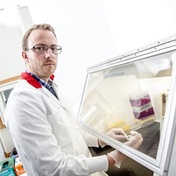Despite all the training, sweat, dedication and sacrifice that goes into becoming an Olympic competitor, these elite athletes also tend to have an advantage that average sports lovers lack: superior DNA. Just like eye colour or a keen intellect, a constellation of the "right" genes can grace certain athletes with world-class speed, strength and endurance.
But with the advent of gene therapy - technology on the cusp of helping treat grave illnesses - are the days of "natural selection" of super-athletes coming to an end?
Genetics and athletics experts fear that the 2012 Olympics, opening Friday in London, may be the last without competitors secretly hinging their gold medal hopes on "gene doping" - modifying their DNA to make themselves bigger, stronger or faster - and that such gene manipulation may one day match the use of illicit performance-enhancing substances.
"Gene doping has been sort of smoldering as a theoretical possibility for at least two or three sets of Olympic Games," said Dr Ted Friedmann, chair of the genetics panel of the World Anti-Doping Agency. "If you ask me how many more years it'll be before it's done, well, I'd say a very long time. But how many more years before some idiot does something stupid? That could be tomorrow," he added.
Gene doping and performance
"The technology is ripe for abuse by badly trained people," explained Friedmann, also director of the Center for Molecular Genetics at the University of California, San Diego. "The chance of effectiveness if done by current methods is almost nil."
According to an article published in the journal Nature, more than 200 gene variants have been associated with athletic prowess, including a variant of the ACE gene linked to endurance and an alternative copy of the ACTN3 gene - dubbed the "speed gene" and found in nearly every male Olympic sprinter ever tested.
While therapeutic gene therapy - injecting foreign DNA into muscle or bone to change a person's genetic makeup, creating proteins that infiltrate tissue or blood - still carries too many side effects be widely used, cases already exist of doping where the protein (rather than the gene that encodes it) is taken to improve performance, said Dr Kathryn North, an Australian researcher whose 2010 study on the ACTN3 gene helped establish its link to sprinters and power athletes.
Examples include the manipulation of the EPO gene, which increases hemoglobin levels, boosting blood's oxygen-carrying capabilities, she said. Finnish athlete Eero Mantyranta, the winner of seven Olympic cross-country skiing medals, naturally carries such a mutation, elevating his oxygen-carrying capacity by 25 to 50%, according to the Nature article.
Doping technology growing
Tests to root out gene-doping are still being developed and aren't ready for prime time, but apparently these rogue proteins can already be detected.
"Gene-doping is not yet a reality, but the technology to detect doping will evolve along with the techniques to misuse the new genetic technologies," said North, head of the Institute for Neuroscience and Muscle Research at the Children's Hospital at Westmead in Australia.
Indeed, an air of inevitability about gene-doping permeates, though Olympics officials will concentrate for the moment on the 4 500 tests already available for banned substances in their efforts to keep the 2012 Games clean.
Robert Kersey, director of the Athletic Training Education Program at California State University in Fullerton, predicted that the pressure to win - twinned with monetary pressure from corporate sponsors - will combine to make gene-doping irresistible to some world-class athletes.
"Humans are greedy and if there's money to be made, people are willing to take those risks," said Kersey, also a professor of kinesiology. "Everyone involved has the potential to make money or fame or fortune out of it . . . you're never going to convince every person who wants to win a gold medal that they shouldn't bend the rules if they feel they have a real chance of winning."
But North and Friedmann pointed out that merely having a favourable gene -- whether for athleticism or any other trait -- doesn't guarantee that gene will express itself in the desired way. A specific combination of many gene variants, in addition to training, environment and attitude, "really make up the complex phenotype that is the elite athlete," North said.
Added Friedmann: "Genes work in an enormously complicated set of interactions, and no gene works by itself. If you have the gene for speed or endurance, all the other genes you carry that [help] or work against that will affect how that gene expresses itself."
Read more:
All about gene therapy
More information
The U.S. Department of Energy's Genome Program offers more about gene therapy.
(Copyright © 2012 HealthDay. All rights reserved.)




 Publications
Publications
 Partners
Partners











